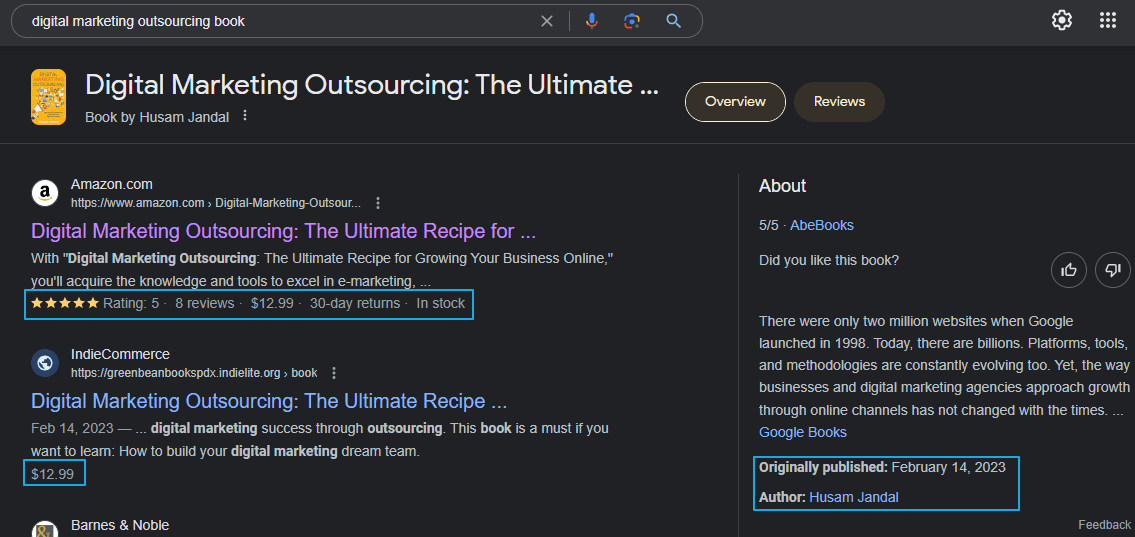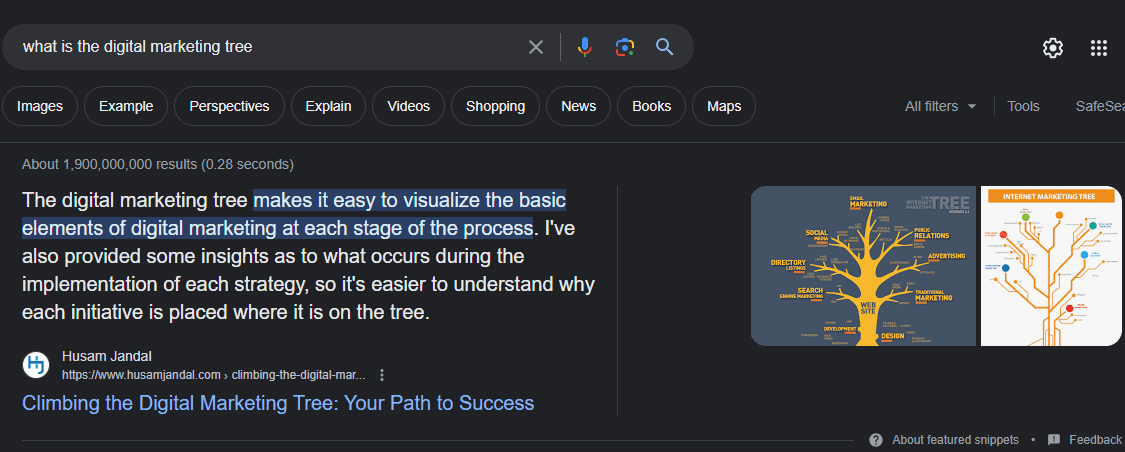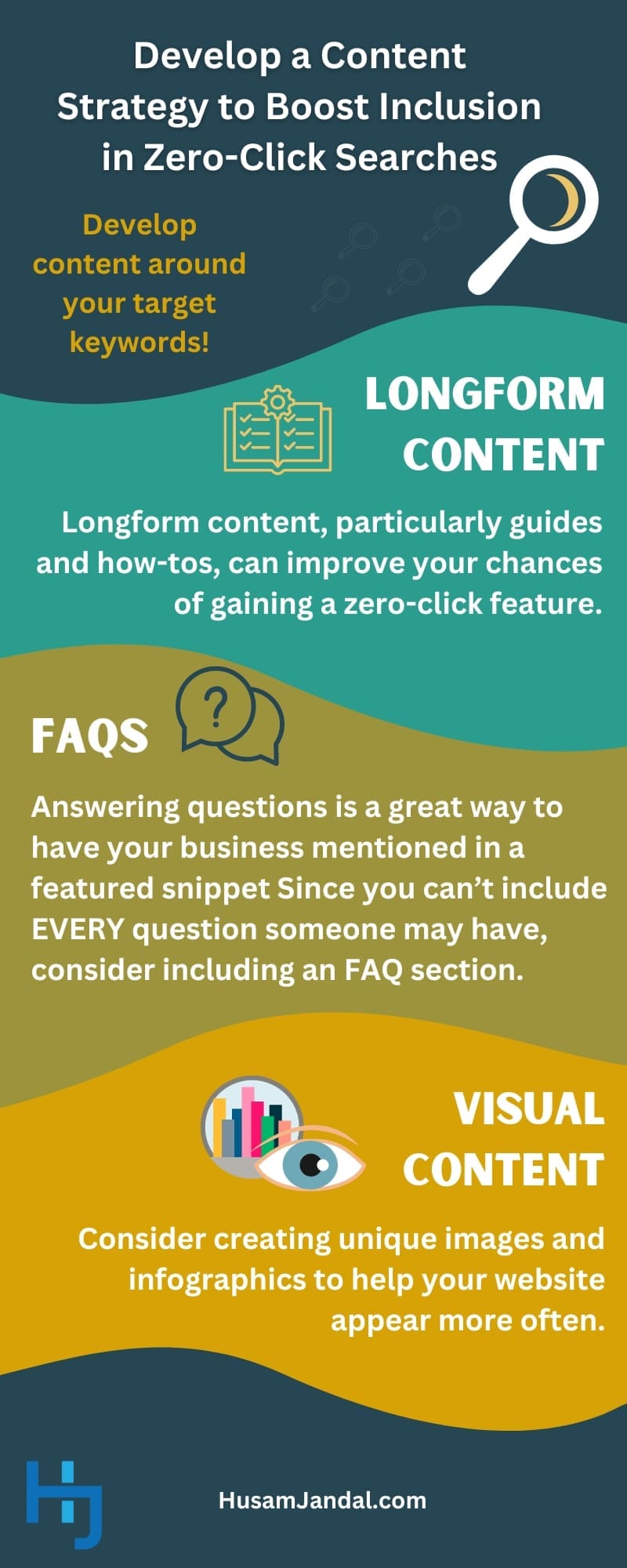 You may have heard a startling statistic making the rounds: more than half of all searches performed on Google don’t result in website clicks. Dubbed “zero-click searches,” these queries are on the rise and have become a significant concern for businesses that rely on traditional search engine optimization (SEO) practices to drive organic traffic to their websites. Should you be worried, too?
You may have heard a startling statistic making the rounds: more than half of all searches performed on Google don’t result in website clicks. Dubbed “zero-click searches,” these queries are on the rise and have become a significant concern for businesses that rely on traditional search engine optimization (SEO) practices to drive organic traffic to their websites. Should you be worried, too?
As a digital marketing consultant who has been supporting businesses virtually since the inception of search engines and has watched countless new trends emerge, I have seen evidence of this shift as well. However, this is not an SEO Armageddon. In fact, savvy businesses can leverage zero-click searches to their benefit. Give me a few moments, and I’ll walk you through what’s happening, how it impacts your SEO, and how to make the most of zero-click searches.
Zero-Click Searches: Definition, Causes, and Prevalence
Before we dig into how to make the most of zero-click searches, let’s quickly review what they are and what they mean for your digital marketing efforts.
What is a Zero-Click Search?

Broadly speaking, any time a user performs a search and doesn’t click on a result, it’s considered a zero-click search. However, a query may not produce a click for many reasons, and not all of them are causes for concern.
Zero-Click Searches Have Many Causes
Zero-click searches can occur when the user:
- Doesn’t receive the results they expect and decides to run a new search. For instance, maybe they typed “veneer” into Google and got a page of results about dental treatment, then refined the search to indicate “wood veneer” to learn about paneling.
- Is searching for a quick fact. For example, when checking the time in a specific time zone or when converting U.S. dollars to Canadian dollars.
- Is treating search like a dictionary or thesaurus. For example, typing the phrase “zero-click search definition.”
- Wants to see a specific location on a map. For example, when looking up nearby bank branch locations.
- Needs specific information about a local business. For example, when looking up a local shop’s hours or phone number.
- Navigates to an app rather than a webpage. For instance, perhaps they typed the name of their bank into search and then discovered a link to the app store in the results.
- Utilizes voice search. For example, perhaps they’re driving and ask Siri where the closest restaurants are.
Only Certain Zero-Click Searches Are a Concern
As you can see, some of these queries aren’t coming from people who would benefit from being connected with a business. Experienced marketers and businesses are more concerned about the searches that used to result in a click-through to a website. Google now answers these types of queries directly on the search engine results page (SERP) in various formats, such as direct answers, featured snippets, and knowledge panels.
Zero-Click Search Results Aren’t as Bad as Some Fear
We can say that more than half of all queries become zero-click searches, and it is technically accurate because 57 percent of mobile users and 53 percent of desktop users don’t click on an organic or paid result, according to SEMrush. However, it’s not the whole story. This broad bucket of zero-click searches also includes:
- Users who stay on Google. For instance, they click a tab that shows them images, news, or shopping within the SERP. Clicking a carousel card or on related searches also counts as a zero-click search.
- Users who run a new search. Perhaps they didn’t find what they were looking for the first time and decided to refine their query.
It’s estimated that around ten percent of users generate a new Google URL, which means these types of scenarios are quite common.
When we account for these situations, just 26 percent of desktop and 17 percent of mobile searches are zero-click. And, even then, some users are clicking apps or engaging in other behaviors that allow them to engage directly with a business even though they’re zero-click.
Common Digital Marketing Practices for Driving Website Traffic Remain Effective
One of the biggest worries businesses have is that all the resources they’ve poured into SEO were for nothing – that they can no longer attract organic traffic because Google is satisfying user needs by supplying information in the SERPs. This isn’t true either.
The number of clicks Google sends to the open web has increased every year since its inception, Google reps say. The search engine presently sends billions of visits to websites daily. Around 45 percent of searches on desktop and 43 percent of mobile searches produce organic clicks for websites. Paid ads still get some clicks, too. However, some of the traffic that top-ranking sites would have received is lost when Google serves up the information without requiring the user to click anything.
Zero-Click Marketing Must be Part of Your Toolkit
There is a growing trend among platforms to keep users where they are rather than sending them to third-party websites. Google zero-click search is only one example. However, you’ll see the same thing on social media sites with zero-click content, also referred to as no-click content.
No-click content is content that’s designed to be consumed on the site the user is actively visiting without needing to click through to another website. Carousels are a great example here. You can view multiple images or even the summary of an entire blog without leaving the social media platform. While search engines and social media platforms are tight-lipped about how their algorithms work, emerging data strongly suggests the algorithms favor no-click content and distribute it more.
In other words, traditional practices still work, but brands must adapt to these new trends if they want to continue receiving high levels of exposure online.
Businesses Can Gain an Edge by Optimizing for Zero-Click Searches
Perhaps the greatest silver lining in all of this is that you can help your brand appear in zero-click results. While it won’t necessarily deliver instant traffic, zero-click SEO is an effective way to boost brand awareness and begin building relationships, so you get their clicks later when they specifically seek your brand out.
Zero-Click Searches: Turning Challenges into Opportunities for SEO Growth
Now that we’ve covered the basics, let’s look at how to optimize for zero-click searches.
Follow SEO and Development Best Practices
Convenience and frictionless experiences are the hallmarks of excellent service today. This is one of the reasons your potential customers actually appreciate zero-click search results and zero-click content. It’s also why following development and SEO best practices remains essential and will help you get your business to appear in more zero-click search results.
SEO Best Practices
Earlier, we discussed how many searches still produce organic website traffic. SEO is crucial to ensuring your site ranks well and collects that traffic. Additionally, newer research suggests that your organic rank influences whether Google features your business in a zero-click search. For instance, 99.58 percent of featured snippets come from sites that Google ranks in the top ten for the related query, according to Ahrefs. In other words, you already have to appear on the first page of Google to have your content featured.
Schema
Schema markup, also called structured data, is code added to your website that helps search engines understand the content better and allows them to display portions of it in a rich format. For example, when Google understands that you’re sharing a product and what various elements are on the product page, it can highlight the rating, number of reviews, price, and other essential details in the SERPs. Similarly, it can leverage the data for things like knowledge panels. Work with your developer to ensure you’re making the most of schema markups to boost your presence on search engines.

Reevaluate Your Keyword Strategy
Take time to reevaluate your current keyword strategy. You’re likely to find new keywords you can use for zero-click optimization or discover keywords you’re already leveraging that you can expand on to help your brand get featured more often. It’s possible to have a single page to be featured in thousands of zero-click searches. Ahrefs, for example, has one that appears in 4,658 featured snippets due to its excellent optimization.
Low CTR Keywords
Keyword discovery tools often provide average clickthrough rates (CTRs). Historically, brands have focused on those with a high CTR because they’re trying to generate traffic. Many still leverage this approach and completely overlook those with a low CTR. In a zero-click world, those can be gold. Be on the lookout for them, especially if they have a higher volume, and develop content around them to help your brand be featured more often.
Informational Searches
Search engines are more likely to feature a slice of content when something can be taken as fact, and the answer is brief. This is often the case with informational searches or when people type questions into the search box. For example, “what is the digital marketing tree?” triggers a zero-click search. Be on the lookout for questions you can answer when you conduct keyword research.

Long-Tail Keywords
Despite the benefits of appearing in zero-click results, generating clicks and traffic to your website should remain a priority. This is where long-tail keywords come in. These are longer and often more specific phrases you’ll see in keyword reports. They tend to receive less traffic, so competitors often overlook them, and you may be able to win them more easily. While some may still be addressed in a way that gets them featured in a zero-click search, they often require more details and necessitate a click.
Voice Search
People often talk to voice assistants such as Siri and Alexa like they’re talking to another person. Whereas someone typing will keep it brief and omit certain words, someone speaking will use fuller sentences and sound more natural. For example, a person typing might run a search for “flight 377 arrival,” but a person speaking might search for “what time does flight 377 arrive at LAX?” Keep an eye out for keywords that sound more like people talk if you’re targeting voice search. Schema markups are also helpful here, as assistants often defer to rich content for answers.
Develop a Content Strategy to Boost Inclusion in Zero-Click Searches
Knowing which keywords to target is the first step. Developing content around them is the next step.
Longform Content
Longform content, particularly guides and how-tos, can improve your chances of gaining a zero-click feature. It also gives you more space to include informational keywords, which comprise 60 percent of unique search queries, according to SEMrush.
FAQs
We know that answering questions is a great way to have your business mentioned in a featured snippet. However, you can’t include every question people might ask about a topic in your core content. It will come out unnatural and redundant. Instead, consider including an FAQ section when it makes sense to do so.
Visual Content
Google often features images in its zero-click results, either as part of an image pack or beside other structured content. Consider creating unique images and infographics to help your website appear more often. These often produce strong results in social media as zero-click content, too, giving your brand more exposure without investing additional resources.
It’s also worth noting that YouTube is one of the top ten most “featured” websites, per Ahrefs research. If producing high-quality videos is part of your digital marketing strategy, optimize the YouTube description to help your videos appear in organic search results and weave videos into your website content as suitable.
Make the Most of Analytics and SEO Tools
Some of the techniques we’ve covered cannot be performed without specialized tools.
Measure and Track Zero-Click Searches
Brands have historically relied on metrics like CTR to help gauge the success of their SEO efforts and select the best keywords. That doesn’t work with zero-click searches. However, several tools can help you identify opportunities and understand the value of your zero-click optimization efforts.
Start with Tools Like Google Search Console
Google Search Console is free and provides vital data, including your performance in search results and how users interact with your listings. It also shows you how many times no-click content has answered a search query.
Layer in Advanced Tools Like SEMrush, Moz, and Ahrefs
When you’re ready to be more proactive with your zero-click SEO strategy, tools like SEMrush, Moz, and Ahrefs can help you understand how your site ranks for specific keywords and identify your strongest pages. Some can even help you identify the best keywords to target, tell you whether a query will trigger a search feature, which type of feature appears, and even let you know if your site is the one featured.
Get Help Improving Your Zero-Click Search Strategy
While zero-click searches might seem like a deterrent to driving organic traffic, they present businesses with opportunities to modify their content and SEO strategies to change this challenge into growth. If your business wants to capitalize on this and other SEO trends as part of a comprehensive digital marketing strategy, contact me for a complimentary consultation.





































































